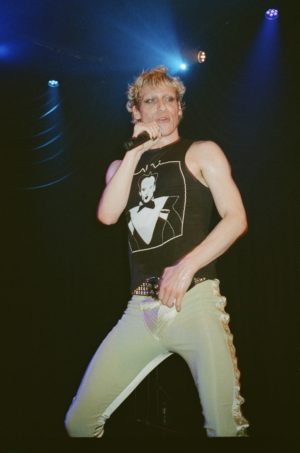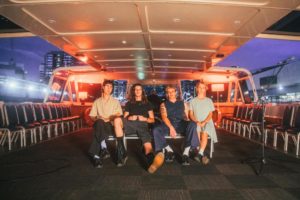Caught in a downpour during a bus ride to Philadelphia a few months ago, I wanted to take the storm in from the safety of my seat, to bask in the mood of a dark thunderstorm before I actually had to get soaked. I swiped over to Rey Pila’s excellent Wall of Goth EP from last year and settled into “No Man’s Land” on repeat as the bus trudged through traffic. Not many synthpop acts know the difference between a texture that fills your ears and one that fills your heart. As soon as the low synth booms just a few seconds into the last track on the EP, your body relaxes and your mind falls into a romantic cybernetic world full of neon lights.
Each and every track could fill its own individual music video with bold and graphic storytelling, similar to the haunting visuals of fan-favorite “Surveillance Camera.” Sure, their beats are great for dancing, but listening to them in the dark lets your imagination run wild with the fodder that Rey Pila has curated across two albums and an EP. Lead singer Diego Solórzano’s deep and sensual vocals are just the cherry on top of their chill-inducing atmosphere.
After releasing Wall of Goth, Rey Pila has slowly teased us with new material that seems to occupy bigger and bigger stadiums. “Fangs” and their cover of Siouxsie and The Banshees’ “Israel” could soundtrack a haunted house dance floor, a darker yet fuller turn for the alt-pop quartet. Before their sold-out Mercury Lounge show earlier this summer, I caught up with the band over pizza to get a glimpse of what’s bubbling under the surface for them. Plus, anyone who draws so much inspiration from the violence and camp of 80s horror movies is a must-see in my book.
Brett: If you could come up with a mission statement for Rey Pila, what would that be? When you’re going into the studio or you’re sitting down to write something, what’s the goal ultimately?
Diego Solórzano: Well, we didn’t know until the these past few years. We were moving forward and just doing music. Getting signed in the U.S. was a big thing. It took us a while, but now that we’re going into the studio, we’ve been doing some recording in Sonic Ranch, now I feel we’re more comfortable and I think the only rule is to take it forward. Try to step into the future and change everything that could be conventional, I know it sounds cliche. Keep working on the songs and try to make it weirder, but, at the same time, poppier. In our dream, it would be pop, future alternative, weird music.
Fuck yeah. Speaking of the future, The Future Sugar sounded bigger than your first album and then Wall of Goth got even bigger. Is that sound part of your goal or has there been some sort of change?
Diego: It’s all about the drums. The drums sound. That’s it. The first record had really shitty drum sounds. Really shitty sounds in general. But for The Future Sugar, we were driving towards bigger drum sounds, like in the 80s. We weren’t that clear as to put a reference on the table like with Wall of Goth. I think that’s one of the reasons the songs sound bigger and bigger and bigger.
Andres Velasco: And I do think we are naturally moving that way. Our music sounds good bigger in a sense. I know some other bands shy away from that and want to keep it more lofi. But, for some reason, we like it. When we play it in the studio, it has to hit you.
I agree. I’ve definitely had a bit of fatigue of really lofi stuff. It gets repetitive at some point. When it comes to references, you guys love basically anything 80s. Has it ever become a problem with people referring to you as just an 80s band?
Diego: We hate that.
Of course. You don’t think of yourselves as that.
Diego: We listen to more 90s stuff, actually. Chemical Brothers, Boards of Canada…We listen to that even more nowadays than we used to.
Andres: Yeah, and we obviously love 80s bands from Depeche Mode to The Cure to Siouxsie and The Banshees to Joy Division. But we also listen to everything. 70s…2018…But we get the 80s reference, but no band likes to be cataloged into a single tag.
Diego: And not all 80s are good. There’s so much nostalgia about the 80s. Like that song “Tarzan Boy?” Is that song a good song? It’s just funny now, that’s it. But the 80s had cool stuff, like the dark goth stuff.
On that topic, do you think there’s a problem with nostalgia within music right now?
Diego: Every video that I see now when I look at modern music videos, they all have the VHS treatment and I think that’s weird because it’s being done too much. I was checking out the Daft Punk video of “Robot Rock,” that album was from 2005 and they were doing the VHS treatment then. That’s a while ago, but now it’s become the thing to do. Everyone wants to look old.
Andres: Stranger Things, the soundtrack for 13 Reasons Why…
These things are now more popular amongst people who weren’t even alive during the 80s. Coincidentally, it’s pretty obvious that you’re big movie fans, especially horror movies. Why do you think that is? I grew up going to the movies every week and it was a big escape for me. What role have the movies played in your life?
Diego: For me, that’s the best moment of the week. I can sit down and fully concentrate in a dark theater and not grab my phone or my computer. And sometimes, it’s not the contents. It’s the package. When you go to see a movie, you instantly get in a mood when you’re in the theater. I don’t get that in concerts anymore. I go to a show, it starts, and then you get distracted. Then you have a beer and you start talking to someone. When we went to see Dunkirk, that Christopher Nolan movie, the second it starts, you’re right in the middle of it.
What about horror movies in particular?
Diego: They kind of put you in a very dark place, but you can see things from the audience perspective and you feel safe. It feels good, the adrenaline. If you see Halloween, you’re the killer all the time so you know where he’s going. But you’re safe, nothing’s going to happen to you. And you have that excitement of being there.
What’s the most scared you’ve been at the movies?
Diego: Lost Highway. That’s probably my favorite movie in general. The David Lynch movie.
I need to catch up on his movies.
Diego: Yeah, and Twin Peaks has some parts that are really scary, like I can’t watch. And, then, it turns out to be funny at the end. But, in Lost Highway, there’s a scene where this guy who has a really creepy face and he finds the main character at a party and tells him that he is at his house right now. The main guy calls his house and the other guy answers, but he’s standing right there.
Andres: I like the classic ones like The Shining and Rosemary’s Baby.
Diego: Oh, yeah, The Shining is pretty scary.
To go back to your sound for a moment, your cover of Siouxsie and The Banshees’ “Israel” was fantastic and it was a pretty big sounding song, too. I know it’s your favorite Siouxsie song, but was there something else that went into deciding that that particular song is worth covering? What would be the criteria for songs that deserve the Rey Pila treatment?
Diego: We have a cover of Chris De Burgh’s “Lady In Red,” which has nothing to do at all with “Israel.” It’s the opposite.
Andres: It’s the b-side on “Alexander.” That was just a good moment. I remember when we were recording The Future Sugar, Chris Cody, our producer, used to play “Israel” in the studio and we immediately loved it and listened and listened and listened. And someday, we just did it and asked him to mix it since he showed it to us. And Siouxsie is a totally underappreciated artist.
Diego: Yeah, she should be huge.
With The Future Sugar, it sounded like you had a lot of stuff that got left out of it. Like “Blast” and “Apex.” It took you guys a while to get that album out, right?
Diego: It went through a few big changes. One was when we recorded with Cody here in DFA. That took two months and he mixed it. Then, when Julian and Cult got into the equation, they also changed it. Julian was the one who told us to bring in three more songs. And our three demos ended up being “Surveillance Camera,” “Fire Away,” and “False Self System.” And he ended up putting those in instead of “Apex” and “Blast.” He swapped songs essentially.
Before and while Cult got involved, what do you think one producer brought to the table that the other may not have and visa versa?
Diego: Julian gets more involved in the sequencing and the songwriting because he’s a songwriter and a singer. Cody’s not a singer/songwriter, but he’s great at textures and he sculpts sounds really well. He’s good with synths. Julian’s just an amazing songwriter. He knows where to put the chorus, even though he says he doesn’t. But he does.
For you, when it comes to songwriting, what was the decision to write songs all in English after the first album? How does the process change between each language? I know English is known to be a bit limited when it comes to writing about emotion.
Diego: It’s actually the opposite for me. I was forced into writing those Spanish songs on the first record. Back then, we were working with a big management company, a terrible big management company. They all wanted money and they said, “You need Spanish songs so we can put them on the radio and we can make money.” The whole thing with us is that we do what we want to do, how we want to do it, and we try to stay pretty faithful to what our shit is. If not, it’s going to go with the wind and disappear.
Andres: It’s weird…not weird…just more natural when we make music in English. It’s the first language that comes to mind when we’re writing. And we’ve all done songs in Spanish and we don’t have a problem with Spanish at all.
Diego: It’s a very romantic language. It’s for a certain type of people to write it. It’s very mellow. I don’t know how to explain it.
Andres: I’ve heard that even some Spanish rock bands, they write in English and then they switch it to Spanish based on that melody. We’ve trained our ears to like rock and it’s mostly in English.
Diego: I didn’t have the same feeling listening to bands that sang in Spanish as I did when I first listened to Nirvana.
Is that the feeling you have to tap into to sing a song like “The Future Sugar”? Does that hurt because you have to scream?
Diego: Yeah, it’s kind of like getting into character and getting really angry for that song.
That’s my favorite song to listen in a car and turn it all the way up and nearly break the speakers.
Diego: Sweet. And by the time we get to that song, I’m usually kinda drunk. Or really shit faced.
Find Rey Pila on Instagram, Twitter, and Facebook.














